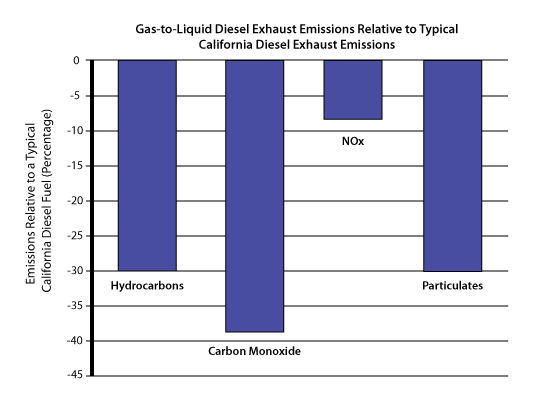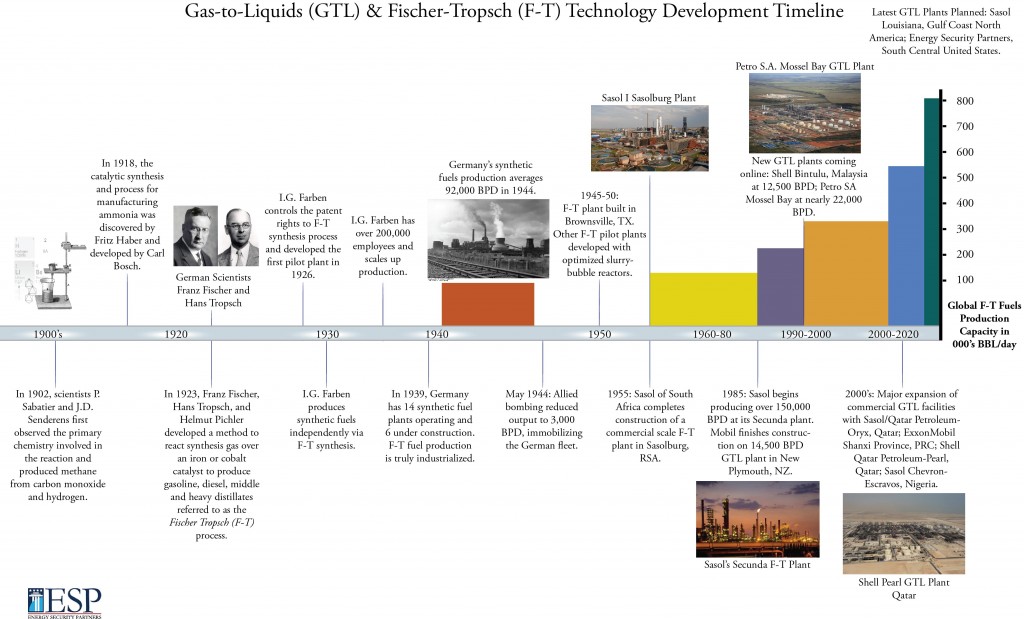Energy Security Partners is developing a world-scale gas-to-liquids (“GTL”) processing facility to produce premium quality clean diesel, motor gasoline and jet fuels from abundant natural gas in North America. The GTL project will employ well-established technology, proven at large commercial scale in existing facilities in operation for many decades. The heart of the technology is the Fischer Tropsch (“FT”) process, developed originally in the 1920s, deployed at commercial scale during WWII to convert coal into liquid fuels, and then perfected at large commercial scale in South Africa beginning in the 1950s.
History of GTL Technology
The following brief history of the development of synthetic fuels is excerpted from a report titled “U.S. Air Force Synthetic Fuels Program, Technical Report APA-TR-2008-0102” by Dr. Carlo Kopp, AFAIAA, SMIEEE, PEng, updated and revised January 2008, further updated April 2012, © 2007 – 2012 Carlo Kopp.
“The Technology of Synthetic Fuels”
“There is nothing new in the basic technology of synthetic fuel manufacture, which is based on 1920s German Fischer-Tropsch chemistry. The heart of the technology is the Fischer Tropsch (“F-T”) process, developed originally in the 1920s, deployed a commercial scale during the 1930s to convert coal into liquid fuels, and then perfected at large commercial scale in South Africa beginning in the 1950s.”
“During the Second World War, Germany built a great many synthetic fuel plants to power its war machine, which had limited access to natural crude oil. Unable to secure the Soviet Caspian oilfields, and with the Rumanian Ploesti oilfields subjected to ongoing air raids, starting with the massive ‘Tidal Wave’ operation, Germany had no choice than to use its most readily available carbon-based fuel, which was coal. With rich coal deposits in Germany, and occupied Poland and Bohemia, a respectable number of large synthetic fuel plants were rapidly constructed [Becker et al, 1981], [Stranges, 2004], [Ludmer, 1946].”
“No differently, during the Apartheid era, South Africa’s SASOL produced synthetic fuels to maintain the nation’s economy and military. The long-running embargo by Western nations simply compelled the Apartheid regime to improvise, and the result today is that SASOL is a major player in the global synfuels industry.”
There are a number of processes via which synthetic fuels can be produced from coal, oil shales or natural gas. Each has unique advantages and disadvantages.
Process Description
GTL technology is based on (i) converting natural gas into synthetic gas (“syngas”) consisting of hydrogen and carbon monoxide, (ii) processing the syngas over a catalyst in a Fischer-Tropsch (“FT”) reactor to create a mixture of gaseous and liquid hydrocarbons, with a large fraction of heavy paraffinic waxy compounds and a smaller fraction of light hydrocarbons (“synfuels”), and (iii) upgrading the synfuels into finished diesel, motor gasoline, jet fuel(s) and other high-quality FT products.
The product slate of market-ready liquid transportation fuel products for most FT systems consists primarily of diesel and naphtha, although jet fuel, gasoline and LPG are co-products in some instances. Liquid fuel products from GTL systems are essentially identical to petroleum-derived liquid transportation fuel products but GTL liquids generally exhibit superior environmental and performance characteristics.

Clean Fuels
The U.S. Energy Policy Act of 1992 designates GTL products derived from natural gas as an “alternative fuels.” The GTL market will be partially driven by the search for such alternative fuels that can minimize environmental impacts but that are also capable of being used directly or blended with conventional fuels without any loss to fuel economy or engine performance in existing gasoline, diesel and jet fuel engines. The GTL process produces a synthetic diesel that is clean burning with lower emissions of regulated pollutants like nitrogen oxides, sulfur oxides, and particulate matter when compared to conventional petroleum-derived diesel fuel. The higher cetane number of GTL diesel also increases performance, reduces “knocks,” and minimizes engine wear and tear (see table below). In fact, GTL diesel is virtually sulfur-free.
Properties of GTL Diesel
| Property | GTL Diesel | ULSD or UE EN 590 |
Euro5 Diesel |
|---|---|---|---|
| Density (kg/m3) | 778 | 835 | 845 |
| Cetane Number | 75 | 53 | 51 |
| Poly-aromatics Max (vol %) | 0 | 4 | 11 |
| Sulfur Max (ppm) | 0 | 10 | 10 |
Similarly, GTL gasoline and GTL jet fuel are virtually sulfur free, clean burning and exhibit lower emissions of regulated pollutants. These GTL products may be used directly in some circumstances or blended with similar petroleum-derived products to yield better performing and environmentally superior transportation fuels.
Environmental Sustainability
The graph below shows that GTL diesel has approximately 30% less hydrocarbon emissions, 38% less carbon monoxide, 8% less NOX, and 30% less particulates emissions compared to petroleum-derived diesel when examining the two fuels on the basis of engine performance.

Image Source: California Energy Commission Consumer Energy Center


